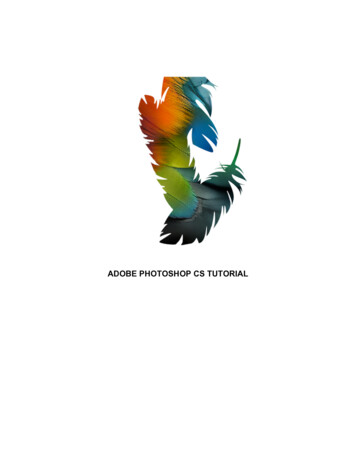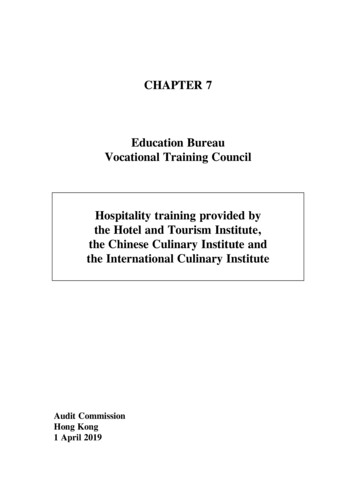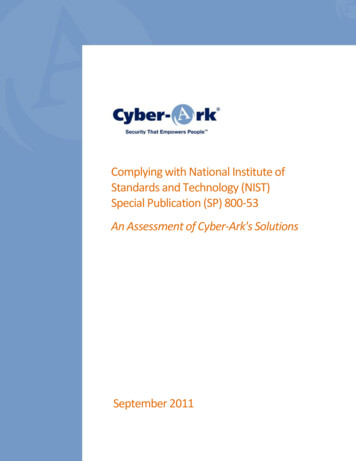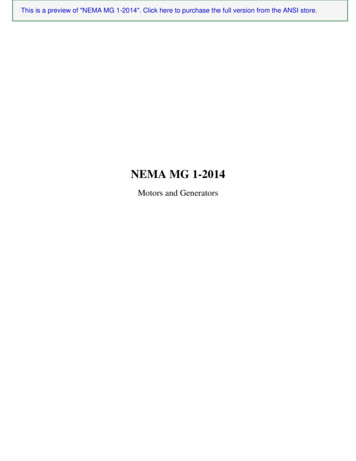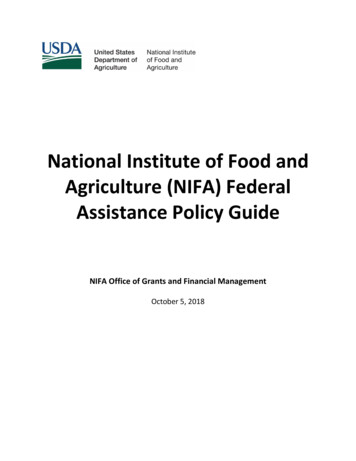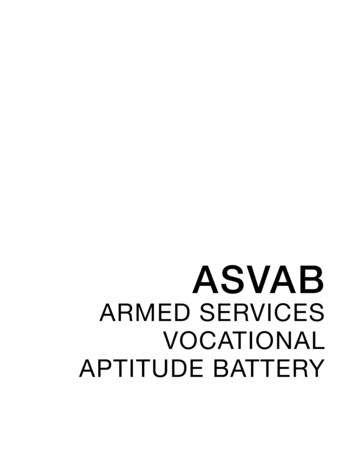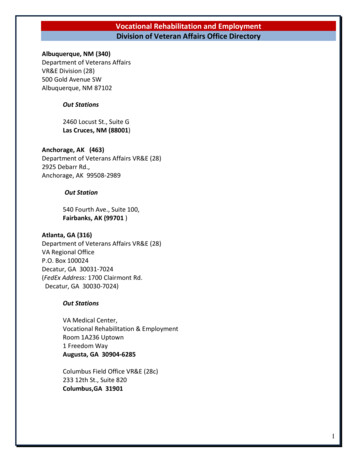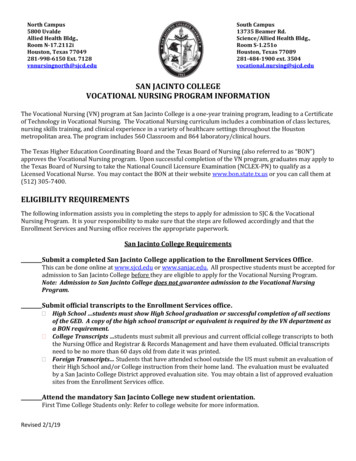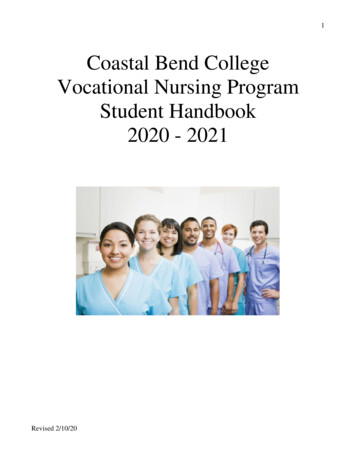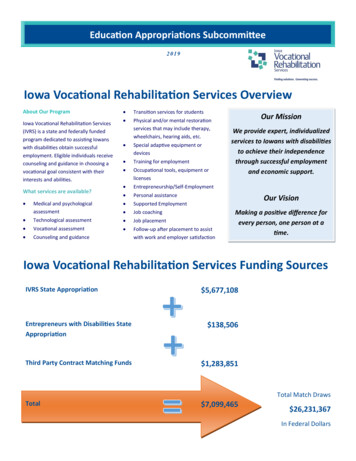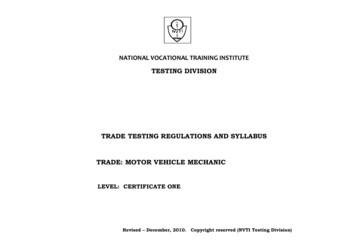
Transcription
NATIONAL VOCATIONAL TRAINING INSTITUTETESTING DIVISIONTRADE TESTING REGULATIONS AND SYLLABUSTRADE: MOTOR VEHICLE MECHANICLEVEL: CERTIFICATE ONERevised – December, 2010.Copyright reserved (NVTI Testing Division)
A.INTRODUCTIONi.The review of this syllabus has been generally influenced by the demands of industries due to itscontinuous change as a result of technological advancement and the changing needs of society.It was also influenced by the TVET reforms under the directions of the new educationalreform with the view to opening up further education and training opportunities to TVETgraduates.The certificate ONE syllabus is designed to respond to the following leveldescriptors:QUALIFICATIONCertificate 1KNOWLEDGE LEVEL1. To demonstrate a broad knowledgebase incorporating some technicalconcepts.2. To demonstrate knowledge of thetheoretical basis of practical skills.3. To demonstrate knowledge innumeracy, literally, IT andEntrepreneurial skillsii.SKILLS AND ATTITUDE:1. Require a wide range oftechnical skills2. Are applied in a variety offamiliar and complex contextswith minimum supervision.3. Require collaboration with othersin a teamThe rational of this syllabus is to establish the level of knowledge and skills required bymechanics over a wide range of applications, including the development of an ability to diagnosefaults, recommend by means of rectifying these faults and to test and analyze the performance ofthe vehicle after repairs or modification has been completed.Revised – December, 2010.Copyright reserved (NVTI Testing Division)
B.THE GENERAL OBJECTIVESThe objectives of this course are to give the apprentices a systematic training both theoretically andpractically. It is expected that much emphasis will be laid on the practical aspect of the training duringin-school and on-the-job training. About 60% could be allocated to practical training centres and otherinstitutions approved by the National Vocational Training Institute.This training syllabus is prepared to serve as a guide for employers, instructors and other parties concernedwith training in the preparation of their individual programmes. It is necessary that trainingbecomeeffectively planned and controlled as effectively as possible so that apprentices derive much benefit fromtheir training.C.THE COURSE COMPONENTSTrade TheoryScience and CalculationTrade DrawingGeneral PaperTrade PracticalEXAMINATION: The candidates would be examined in the FIVE components listed in ‘C’ above.Practical work must be carefully planned to illustrate application of the theory and to providemaximum opportunity for shop practice, laboratory work and demonstration.D.KNOWLEDGE AND SKILLS REQUIREMENTThe prime objective of the programme is to provide knowledge and skills of the trade in a mannerthat will best meet the needs of the trade as well as industries using professional equipments.Revised – December, 2010.Copyright reserved (NVTI Testing Division)
E.ENTRY TO THE COURSEMinimum education: Must have passed JHS or SHS examination/Foundation certificate. However, theselection of the students for the course is within the discretion of the head of the institution.F.ELIGIBILITY FOR ENTRY TO EXAMINATIONCandidates may enter for examination only as internal candidate; that is those who at the time of entryto the examination are undertaking (or) have already completed the course at an approved establishment.G.EXTERNAL EXAMINERSThe practical work of candidates will be assessed by an external examiner appointed by the Trade TestingCommissioner.H.EXAMINATION RESULTS AND CERTIFICATESEach candidate will receive record of performance given the grade of performance for the componentsTaken. These Certificates would be issued to candidates who pass in all the components.NOTE:All Technical and Vocational trainees who aspire to take advantage of the opportunities opened to themin the educational reforms should NOTE that, for a trainee to progress to certificate Two (2) a pass inCertificate One (1) is compulsory.Revised – December, 2010.Copyright reserved (NVTI Testing Division)
I.APPROVAL OF COURSEInstitutions or other establishments intending to prepare trainees for the Examination must apply toTHE COMMISSIONERTESTING DIVISIONNVTI, HEAD OFFICEP.O. BOX MB 21, ACCRAJ.ACKNOWLEDGEMENTNVTI wishes to acknowledge the preparatory material done by the team of Experts, which have beenincorporated into this syllabus.RECOMMENDED BOOKS FOR MVM1.The Repair of Vehicle Bodies(Allan Robinson)2.Principles of Auto Body Repairing and repainting(A. G. Deroche)3.Auto Body Repair and Refinishing(John W. Hogg)4.Fundamentals of Motor Vehicle Technology by: V.A.W. Hillier and E. Pittuck (4th Edition)5.Motor Vehicle Technology and Practical Work by: J.A. Dolan (Combined Volume Part 1&2)6.i.ii.Technology for Motor Mechanic Part 1 (Book 1) Tools and Materials 3rd Edition by S.C.MuddPart 2 (Book 2) Vehicle & Electrical Technology by S.C. Mudd (3rd Edition)iii.Part 3. Technology for Motor Mechanics Vehicle and Electrical Technology byRevised – December, 2010.Copyright reserved (NVTI Testing Division)
S.C. Mudd (3rd Edition)Part 4 (Book 4) Vehicle Technology Diesel (C.I. Engines) By S.C. Mudd (3rd Edition)7.SCIENCE AND CALCULATIONS8.i)Motor Vehicle Science and Calculations Book 1 & 2 By R.C. Champion andE.C. Arnold (New Edition)ii) Motor Vehicle Science and Calculations Book 1 & 2 By Zammit, Saviour J.(3rd Edition).9.TECHNICAL AND ENGINEERING DRAWINGi)10.Engineering Drawing with CAD Applications by Ostrowsky and Edward ArnoldMOTOR VEHICLE ELECTRICAL AND ELECTRONICS (M.V.E.)i.Motor Vehicle Electrical and Electronics by V.A.W. Hillier and E. Pittuck 3rd or 4thEditionTOOLS1.2.3.4.5.6.7.8.9.10.Set of flat spannersset of ring spannersset of socket wrenchesset of Allen keysset of flat screw driversset of Philip (star) screw driversPliersAdjustable spanners 9small, medium and large sizes)Feeler gaugeTorque wrenchRevised – December, 2010.Copyright reserved (NVTI Testing Division)
11.12.13.14.15.16.17.18.19.20.21.22.Valve lapping (grinding) stick and pasteBall pein hammerRawhide/mallet hammerHacksaw frame and bladesChiselsFiles (single cut, double and rasp cut)Tin shearsScrapersReamers and punchesPiston clampOil canGrease gunEQUIPMENT1.2.3.4.5.6.7.8.9.10.11.12.13.14.Vice5 tonnes hydraulic jackDrilling machineSurface plateVee blocksAngle plateTry square/steel rulemicrometer - 0 – 25mm range25 – 50mm range50 – 75mm rangeVenier caliperInternal micrometerDial gaugeAlignment gaugeTiming light (stroboscope )HydrometerRevised – December, 2010.Copyright reserved (NVTI Testing Division)
CERTIFICATE ONE – TRADE THEORYNO.1.0.2.0.TASKCRITICAL POINTSINTRODUCTION TOAUTOMOTIVECAREERSUse service manual to findtorque specification to correctlytighten engine/vehiclecomponentsTOOLS ANDEQUIPMENTSelect the correct tool orequipment for a givenoperation.SUB - POINTSIdentify various parts in thevocationa.b.c.d.e.f.Torque wrenchFileChiselHammerValve spring compressor.Spanner (assorted) etc.ii) Special purposeequipmenta. Calipersb. Steel rulec. Feeler gauges, etc.iii) Other WorkshopEquipmentsa. Drilling machineb. Air Compressorc. Axle standd. Bench vicee. Grinding machinef. Mobile crave, etc.Revised – December, 2010.INSTRUCTIONALTECHNIQUESFamiliarization visit throughrotational training in theshops within the trainingcentre and automotive dealershops.Using hand tools, helpstudents to learn the safe useof the tools.Discuss how the measuringinstruments and otherequipment listed are used inthe auto industry payingattention to safetyprecautions.Copyright reserved (NVTI Testing Division)
NO.3.04.0.TASKSAFETY PRECAUTIONTESTING ANDMEASURINGINSTRUMENTS ANDGAUGESCRITICAL POINTS3.1 Differentiate between thevarious types of safety in aworkshop4.1 Identify types ofmeasuring devices and gaugessuch as Rule, Micrometer,(inside, outside and depthdigital micrometer).Viewer caliper4.1.2 Gauges: Dial gauge,small hole gauges, go-no-gogauges, compression gauge,tyre pressure gauge andvacuum gauges.4.1.3 Meters: Dwell meter,Tacometer and Multimeter.SUB - POINTS3.2 Note types of safety in theworkshop:A) Personal Safety in theWorkshop.i. Good ventilation.ii. Cleanliness of shop.iii. Proper use of protectiveclothing.iv. Provision of guard aroundrotating parts.v. Proper storage of inflammablematerialvi. use of rigid support for raised4.2 Select and use feeler gaugesto measure valve clearance tospecification.Use a rule, micrometer to measurelength, diameter of a rod anddepth of a hole.Use a vernier caliper to measurediameter of a cylinder bore.INSTRUCTIONALTECHNIQUES3.3 Discuss with thestudents thefollowing:a) Importance ofsafety in a workshop.4.3 Guide studentsto use the variousinstruments andgauges to measurethe variousspecificationsmentioned in the subskills.Use a dial gauge to determine flywheel concentricity and the use ofcompression gauge.Use multimeter to measurevoltage, current and resistance,etc.Revised – December, 2010.Copyright reserved (NVTI Testing Division)
NO.5.06.0TASK5.0 MaterialsSecuring devicesCRITICAL POINTSAppearance, properties, usesand identification of materials,e.g. Steels, cast iron, copper,aluminum, lead, tin, brass,bronze, plastics6.1 Thread types and sizes;(BSF, BA, UNF, UNC). Nut,Bolts, Philip Screw, Wing andthumb nut and pins, etc.6.1.2 Locking devices: Lockingplates and self lock nuts, pitchbolts and locking wire.6.1.3 Sealing devices: Gasketjoints, plugs, sealingcompounds, oil seals, etc.6.1.4 Pipe unions and joints:Copper, flexible, plastic pipes,straight coupling, elbow union,swaged and pipe fixing, loseclip, etc.7.0 Basic Metal Works(Bench Fitting)7.1 The trainee should be ableto carry out the following:i. Filling.ii. Sawingiii. Drillingiv. Marking out, etc.SUB - POINTS5.2 The trainees shouldconstruct, chisel, drill, drift,spanner with a selected suitablematerial.6.2 The trainee should be able toknow the difference betweenvarious threads, bolts, nuts,locking and sealing devices, etc.6.2.1 Trainee should be able toidentify thread pitch class, seriesand designation.INSTRUCTIONALTECHNIQUES5.3 Guide studentsto identify and selectsuitable materials forthe partsconstruction.Guide trainees toidentify suitable tapsand dies to performrethreadingoperations.6.2.2 Trainees should be able torethread fasteners and extractbroken stud or bolt7.2 Effective use of the following7.3 Demonstrate howtools; e.g. Files, Hacksaw, Drill bit, to carry out theMarking out tools, etc.following operations:Filling, Sawing,Drilling, Marking outto construct an objectsuch as ‘Light ‘G’Clamp, or Try SquareRevised – December, 2010.Copyright reserved (NVTI Testing Division)
NO.TASK8.0 Introduction to themotor vehicleCRITICAL POINTS8.1 The student will be ableto:8.1.1 Identify the types ofbody chassis construction anddrive arrangements of themotor vehicle.8.1.2 Describe the maincomponents and theirpositions in the motor vehicle.8.1.3 Explain the functions ifthe main components of themotor vehicle9.019.02ENGINETYPES OF ENGINESUB - POINTS8.2 Body, chassis and drivearrangements of vehiclesComponents and position inmotor vehicles: Cars and- trucks- clutch- Gear box- Propeller shaft- Rear8.2.1 Main Components andtheir functions:i) Engineii) Transmissioniii) Bodyiv) Steeringv) Suspensionvi) Wheels/tyresvii) Brakesviii) Clutchix) Gear boxPurpose of an engineIdentify the two types of engine-i) Petrol/LPGii) Diesel /BiodieselRevised – December, 2010.INSTRUCTIONALTECHNIQUES8.3 Guide students toinspect and discuss thedifferences in the body,chassis and drivearrangement of i) Cars ii)trucks.Guide students toobserve, describe anddiscuss why the maincomponents arepositioned in theirvarious places in carsand trucks.Discuss the functions ofthe main components ofcars and trucks.Guide students toobserve the methods ofsecuring and locking thecomponents to thechassis.9.3 Guide students todiscuss the purpose ofthe engineUse sketches, chart orreal engines to guidestudents differentiatebetween petrol engineand diesel engine.Copyright reserved (NVTI Testing Division)
NO.9.039.04TASKENGINECLASSIFICATIONCRITICAL POINTSClassify engines by:i) Valuesii) Number and Arrangementsof Cylindersiii) Methods of cooling.iv) Method of ignitionv) Number of strokes.vi) Firing orderENGINE COMPONENTSAND FUNCTIONSDescribe the main componentparts of the engineSUB - POINTSMain parts of the engine:i) Engine block.ii) Cylinder headiii) Crash shaftiv) Fly wheelv) Connecting rodvi) Piston and ringsvii) Camshaftviii) Valvesix) Tappets, etc.Revised – December, 2010.INSTRUCTIONALTECHNIQUESUsing a dismantledengine, discuss thevarious componentslisted in the sub-skillsand their positions inthe engine and alsocarry outmeasurement andalignment of thepiston con – rod,camshaft, etc.Copyright reserved (NVTI Testing Division)
NO.10.0TASKPRINCIPLES ANDOPERATION OFENGINESCRITICAL POINTS10.1 The student will be ableto :Describe the operation of theof-stroke and 4-stroke petrolengines.10.1.1 State the advantagesand disadvantagesof petrol and diesel engines.10.1.2 Differentiate betweenthe main parts of single andmulti cylinder engines.11.0Valve operatingmechanism11.1 The students will be ableto:- Explain the function of valveoperating mechanism on anengine.- Explain the meaning of valvetiming terms.- Perform valve timing on anengine.SUB - POINTS10.2 Principles and operation ofthe 2-stroke, 4-stroke internalcombination engine.10.2.1 Advantages anddisadvantages of Petrol andDiesel engines.10.2.2 Comparison of mainparts of single and multicylinder engines11.2 Crankshaft positions andvalve operating mechanism for- Side valve.- Overhead valve- Overhead camshaft.Valve timingi) Leadii) Lagiii) OverlapRevised – December, 2010.INSTRUCTIONALTECHNIQUES10.3 Use sketches orchart to explain theconstruction andoperation of 2 and 4stroke Petrol and Dieselengines.10.3.1 Discuss theadvantages of petrol anddiesel engines.10.3.2 Guide students todismantle 2 and 4stroke petrol and dieselengines.10.3.3 Examine thecylinder bore, crank shaft,valve seat and face, etc.for wear and cracks.11.3 Use sketches orcharts to explain theoperating mechanism.- Assist students todiscuss the meaning ofthe valve terms listed inthe sub-skills.- Guide students toperform valve timing onan engine and determinethe overlap period.- Students to performvalve adjustment onCopyright reserved (NVTI Testing Division)
NO.12.013.014.0TASKCRITICAL POINTSCYLINDER HEADOVERHAULING(DECARBONISING)12.1 Dismantling cleaningand examination ofcylinder head.- Dismantle valves, clean anddecarbonizes.- examine cylinder head forcrack, bend and seat wear.CRANK ARRANGEMENTAND FIRING ORDERS13.1 Identify crankarrangements and firingorders.- State the reasons for givingvalve clearance differences e.g.Exhaust and inlet valves.FUEL SUPPLY SYSTEMS 14.1 The students will be ableto:Explain the purpose of the fuelsupply system.SUB -POINTSINSTRUCTIONALTECHNIQUESoverhead and side valveengine.- Assist students tostudy methods ofconnecting camshaftand identify timingmarks provided on theengine.12.2 Use appropriate cleaningagents and valve seat and facegrinding paste to lap in valve.12.3 Guide students inthe use of cleaningagents and appropriatetools13.2 Crankshaft arrangementand firing orders:- 2, 4 and 6 cylinder in-lineengines13.3 Guide students toexamine the crankarrangement of a 4 and6 cylinder in – lineengines noting theirfiring orders.- 2, 4, and 6 cylinder vice cylinderengines.- 4 cylinder opposed.14.2 Fuel supply system that isPetrol and DieselRevised – December, 2010.14.3 Use sketches orchart to explain thepurpose of the fuelsupply systems (Petroland Diesel)Copyright reserved (NVTI Testing Division)
NO.15.0TASKPETROL SUPPLYCRITICAL POINTS15.1 Sketch the layout ofpetrol supply system Explainthe function of the maincomponents.Describe the operation ofpetrol supply system.16.0FUELS16.1 State the properties ofpetrol and diesel fuels17.0SUB - POINTS15.2 Layout and maincomponents:i) tankii) pipelineiii. filteriv. pumpv carburetor/ injectorINSTRUCTIONALTECHNIQUES15.3 Guide students todiscuss the maincomponents of a fuelsupply systemFUEL PUMP16.2 Properties of fuels.17.1 Describe theconstruction and operation ofmechanical and electrical fuelpumps, sketch and label themain parts.State the advantages anddisadvantages of mechanicaland electrical fuel pumps.17.2 Mechanical andElectrical fuel pumps.Dismantling and reassemblinga mechanical fuel pump.Dismantle and reassemble amechanical fuel pump and testfor satisfactory operationSketch and label the multi-jetcarburetor and describe itsoperations.Revised – December, 2010.16.3 Assist students todiscuss the compositionof petrol and diesel fuels.17.3 Use sketches orcharts to- explain theconstruction andoperation of mechanicaland electrical fuelpumps.- Students to sketch andlabel the main parts ofthe mechanical andelectrical fuel pumps.Guide students todismantle a mechanicalfuel pump, examine theparts, reassemble andtest for satisfactoryoperation.Copyright reserved (NVTI Testing Division)
NO.18.0TASKEXAMINATION OF ACARBURETOR19.0ELECTRONIC FUELINJECTION20.0ELECTRONIC FUELINJECTIONINSTRUCTIONALTECHNIQUESCRITICAL POINTSSUB - POINTS18.1. Dismantling, examiningand assembling of carburetor.18.2.1 Examine thecarburetor jet for blockage andleakage.19.2 Electronic injectionsystem.18.3.1 Assist trainees todismantle and assemble acarburetor19.3 Guide students todiscuss the purpose of theelectronic fuel system20.2 Types of systems:i)Single point injectionii) Multi point injection20.3 Use sketches, chartsor real object to guidestudents to examine thelayout of the petrolinjection system on avehicle and identify thetypes. I) Single point ii)Multi point19.1 The students will be ableto:- Explain the purpose of theelectronic fuel injectionsystem.20.1 Identify and name thetwo petrol injection systems.Name the various componentsof the electronic fuel injectionsystem and describe their role.Name the role of componentsof the electronic fuel injectionsystem.Identify and name thevarious components of theelectronic fuel injectionsystem i) ElectronicControl Unit (ECU).ii) Sensorsiii) ActuatorsRevised – December, 2010.Copyright reserved (NVTI Testing Division)
NO.21.0TASKCOMPRESSIONIGNITION ENGINE (CI)FUEL SYSTEMCRITICAL POINTS21.1 Basic operation andpurpose of the maincomponents.- Comparison of itsadvantages and disadvantagesover the carburetor system.SUB - POINTSINSTRUCTIONALTECHNIQUE21.3 Guide students toi) remove and replace fuelfilters, bleed air from thesystem.21.2 Consider safetyprecaution required in carryingout procedure.- Phasing and calibration.- Setting of maximum andminimum fuel delivery of thein-live injection pump.- Pressure setting and spraypattern.ii) Explain anddemonstrate the procedureof phasing and calibrationof injection pump.iii) Explain the purpose ofheater plugs and state theirlocation on the engine.iv) Explain the importanceof fuel filtration.- Timing of injection pumpfitted to an engine.Revised – December, 2010.Copyright reserved (NVTI Testing Division)
NO.22.0TASKFUNDAMENTALS OFELECTRONICSCRITICAL POINTS22.1 Explain the termelectronics.SUB - POINTS22.2 Auto electronicsIdentify and list the electroniccomponents on a vehicle.Electronic Components:i) diodesii) transistorsiii) resistorsiv) capacitorsv) LEDvi) transducervii) coilviii) motorDescribe the functions of eachcomponents.Functions of the components.Identify the electronic symbolsin a circuit.Symbols in a circuit.Revised – December, 2010.INSTRUCTIONALTECHNIQUES22.3 Guide students tobrainstorm the meaningof the term electronicsand use sketches, chartsor real objects to showthe various electroniccomponents used on themotor vehicle.Guide students todiscuss the functions ofthe electroniccomponents used onmotor vehicles and usechart or sketches todiscuss the symbols usedin electrical andelectronic circuits.Copyright reserved (NVTI Testing Division)
NO.22.0TASKIGNITION SYSTEMCRITICAL POINTS22.1 The students will be ableto:- explain the purpose of thecoil ignition system.SUB - POINTS22.2 Coil ignition systeminclude the following:- Battery- Ignition switch- Coil- Distributor- Condenser- Spark plug- Balart resistor- Dwell angleAdvance and retardmechanismsINSTRUCTIONALTECHNIQUES22.3 Guide students toi) Inspect and study thecoil ignition circuit notingtheir functions ofcomponents in the system.Ii) Dismantle, service andreassemble the distributor.iii) Check and tracemalfunctioning simple coilignition and rectify faults.iv) Study relationshipbetween piston, valveopening and distributoroperation. Identify anytiming marks provided.23.0INTRODUCTION TOELECTRONIC IGNITIONSYSTEM.23.1 Identify types ofelectronic ignition system:i) Inductiveii) Hall effect23.2 Advantages ofElectronic Ignition SystemExplain the advantages ofelectronic ignition system ascompared to the conventionaltype.Revised – December, 2010.v) Fixing of distributor tothe engine23.3 Use sketches or chartsto:i) Explain the operation ofelectronic ignition using thesystem of a) inductive ii) halleffect.Guide students to discussthe advantages of theelectronic ignition system ascompared to theconventional ignitionsystem.Copyright reserved (NVTI Testing Division)
NO.24.0TASKLUBRICATION SYSTEMCOMPONENTS OF THELUBRICATION SYSTEM.25.0ENGINE CRANKCASEVENTILATIONCRITICAL POINTS24.1 The purpose of thelubrication system.SUB -POINTS24.2 Purpose of lubricationsystem and types:i) wet sump ii) dry sumpDescribe how oil is distributedin the engine.Modes of distributioni) Splashii) Mistiii) Pressure.State the functions ofcomponents in lubricationsystem.25.1 The purpose of thecrankcase ventilation system.INSTRUCTIONALTECHNIQUES24.3 Use sketches or chartto show the layout andpath of oil flow of the wetand dry lubricationsystems.Discuss the mode of oildistribution in the engine.Identify the followingcomponents:i)oil pumpii)oil switchiii)oil galleryiv)oil filtersGuide students to servicethe components listed inthe sub-skills.25.2 Identify their positionson the engine.25.3 Guide students toi) Identify the type ofventilation system on anengine explain theoperation of the crankcaseventilation system usingsketches or chart.Describe the operation of thepositive type ventilationsystem.Explain the purpose of safetywarning devices:i)oil pressure relive valveii) oil pressure warning lampiii) oil gaugeiv) dip stickRevised – December, 2010.Guide students to identifythe devices on a vehicle andexplain their purposes.Copyright reserved (NVTI Testing Division)
NO.26.0TASKLUBRICANTSCRITICAL POINTS26.1 State the purpose oflubricants.SUB - POINTS26.2 Lubricants:i) oilii) greaseIdentify the type of lubricantsused in vehicles.i)ii)iii)iv)enginegear boxfinal driveshub, steering, etc.27.0OIL RATINGS27.1 The terms used for oilratings.27.2 Oil terms:i) Viscosityii) SAE numbersiii) Viscosity indexiv) API28.0COOLING SYSTEM28.1 Purpose of coolingsystem and the function of themain components.28.2 The function of thefollowing components:a) radiatorb) thermostatc) water pumpd) fanTypes of cooling system:a) Liquid coolingb) Air coolingIdentify the construction of thea) Water coolingb) Air coolingRevised – December, 2010.INSTRUCTIONALTECHNIQUES26.3 Discuss the needfor lubricants in vehicles.Students should use thedipstick to check the oillevel in the bump.Guide students todifferentiate between thefollowing lubricantsi) engine oilii) Gear oiliii) Grease27.3 Assist students toexplain the followinglubricating terms:i) Viscosityii) SAE numbersiii) Viscosity indexiv) API28.3 Guide students todismantle, examine andreassemble the followingcomponents in thecooling system:a) radiatorb) water pumpc) fanCopyright reserved (NVTI Testing Division)
NO.29.030.0TASKTYPES OF LIQUIDCOOLING SYSTEMAIR COOLING SYSTEMCRITICAL POINTS29.1 Describe the operation ofwater cooling system.SUB -POINTS29.2 Operation of watercooling system:i. thermosyphonii. Pump assisted30.1 Describe the operation ofthe air cooling system.Compare the advantages anddisadvantages of water and aircooling systems.Water and air cooling:Advantages and disadvantagesState the causes of overheatingin the cooling system.Causes of overheating:i) air cooling systemii) water cooling systemRevised – December, 2010.INSTRUCTIONALTECHNIQUES29.3 Guide students toexplain the operation of:i.Thermosyphoncooling systemii. Pump assisted(pressurized)iii. Explain theadvantages anddisadvantages of the twosystems.30.3 Guide students toexamine the air coolingsystem noting theconstruction of the finsand blower.Dismantle, examine andreassembled:a) air cooling systemb) Pressurized coolingsystemCopyright reserved (NVTI Testing Division)
NO.31.0TASKTRANSMISSIONSYSTEMCRITICAL POINTS31.1 The students will be ableto:- Explain the purpose of thetransmission system- Identify the types oftransmission.The main components of thetransmission system and statetheir functions.32.0CLUTCHFAULT DIAGNOSIS(CLUTCH)31.2 Types of transmissioni)manualii) automatic31.3 Use charts orsketches to explain thebasic principle of manualand automatictransmission.Transmission system maincomponents:i) Clutchii) Propeller shaftiii) Gear boxiv) Final drivev) DifferentialUse sketched or realobject to show the layoutof the conventionaltransmission system of avehicle.32.1 Describe functions of theclutch.Identify the types of clutch33.0SUB - POINTS33.1 Diagnose and rectifyminor faults.Bleed the hydraulic clutchsystem.INSTRUCTIONALTECHNIQUES32.2 Types of clutches:i) Single plate:a) multi – springb) diaphragm springii) Multi - plate33.2 Fault diagnosis:a) Excessive Pedal free play.b) Slipc) Dragd) JudderBleeding Hydraulic ClutchSystem.Revised – December, 2010.32.3 Discuss thefunctions of a clutch invehicles.Use sketches, charts orreal objects to explain theconstruction andoperation of single andmulti-plate.33.3 Guide students toi) examine the variousclutch units noting anyfault found.ii) Bleed the hydraulicclutch systemiii) Adjust clutch pedalfree play.Copyright reserved (NVTI Testing Division)
NO.34.035.0TASKGEAR BOXPROPELLER SHAFTUNIVERSAL JOINT.CRITICAL SKILLS34.1 The purpose of the gearbox and describe operation ofvarious types of gearbox35.1 Identify the various typesof:i) propeller shaftii) universal jointSUB - SKILLS34.2 Types and operation ofgearboxes:i) Sliding meshii) Constant meshiii) Synchromesh35.2 Propeller shafts:i) open typeii) torque tubeUniversal joints:i) Constant velocity joint.ii) Hookes jointiii) Layrub jointCarry out checks on propellershaft for bow and twist36.0REAR AXLE36.1 The purpose, theconstruction and operation ofthe rear axle.Sketch and label the maincomponents of the rear axle.36.2 Main components:i) Differential unitii) Crown wheel and pinioniii) Half shaftiv) Oil sealv) Hub bearingRevised – December, 2010.INSTRUCTIONALTECHNIQUES34.3 Guide students toremove and dismantlesliding mesh, constantmesh and synchromeshgear boxes.ii) Check component forwear.iii) Check gearengagement mechanism.vi) Remove and refitbearings, bushing andbeams.35.3 Guide students inremoval and installationof the propeller shaft anduniversal joints etc.Guide students to usecorrect equipment tocheck a propeller shaftfori) Bowii) twistGuide students toobserve the method ofactuating the clutch on avehicle.Copyright reserved (NVTI Testing Division)
NO.37.038.0TASKThe differential unitBraking SystemCRITICAL POINTSTypes of rear axle gears andexplain where it is used37.1 i) Detail informationabout differential.ii)Function of thedifferential unitiii) Types of hub constructionSUB -POINTSMain types of rear axle gearsi) Plain bevelii) Spiral beveliii) Hypoid bevelWorm gear typesINSTRUCTIONALTECHNIQUESGuide students todismantle, examine andidentify the function ofeach part of the clutch.Reassemble and adjustclutch.37.2 Operational principles ofthe differential unit.Check clutch pedal freeplay.37.3 Dismantledifferential unit andstudy variouscomponents.38.1 The purpose of thebreaking system.38.2 Hydraulic brakearrangement.Sketch the layout of thehydraulic braking system,label its parts and describe theoperation of the system.Layout, types and operation ofhydraulic braking system:i) drum typeii) disc typeCompare the drum brake anddisc brakes and state itsadvantages and disadvantages.comparison of drum and discbrakes.Revised – December, 2010.Dismantle, identify partsin each type and reassemble.38.3 Use sketches orcharts to explain the i)purposeii) types of the brakingsystem.iii) discuss the operationof drum brakes usingleading and trailingshoes and also theoperation of the discbrake. Guide students toinspect various oftypes of hydraulicbraking system.Copyright reserved (NVTI Testing Division)
NO.39.040.0TASKBRAKE LININGMATERIALSFAULT DIAGNOSISCRITICAL POINTSSUB - POINTSINSTRUCTIONALTECHNIQUESi. Drum brakesii Disc brakesiii. Dismantle andreassemble39.3 Discuss withstudents the compositionof brake lining materialand method ofattachment to show padsupport plate.39.1 Analyse the compositionof brake lining material andmethods of attachment.39.2 Brake lining material.Outline the requirements forbrake fluid.Brake fluid requirements.a) Explain the need forthe use of brake fluid inthe hydraulic brakingsystem.b) Safety requirementfor handling brake fluid.40.1 Rectify simple brakefaults40.2 Brake faults;i) Lack of stopping power.ii) Grabbing brakesiii) Brake pulling to one sideiv) Spongy pedal.40.3 Guide students todiagnose brake faults ofvehicle and rectify.Revised – December, 2010.Copyright reserved (NVTI Testing Division)
NO.41.0TASKSUSPENSION SYSTEMCRITICAL POINT41.1 The purpose and identifythe types of suspensionsystems.Sketch the layout of the rigidand independent suspensionsystems and state its workingprinciple.SUB - SKILLS41.2 Types of suspensionsystemsi) Rigidii) IndependentLayout of Rigid andindependent suspensionsystem and working principleof;i) Wish boneii) Macpherson typesRevised – December, 2010.INSTRUCTIONALTECHNIQUES41.3 Guide students toexamine different types ofsuspension system, takingnote of arrange
5. Motor Vehicle Technology and Practical Work by: J.A. Dolan (Combined Volume Part 1&2) 6. i. Technology for Motor Mechanic Part 1 (Book 1) Tools and Materials 3 rd Edition by S.C. Mudd ii. Part 2 (Book 2) Vehicle & Electrical Technology by S.C. Mudd (3 rd Edition) iii. Part 3. Technology for Moto
